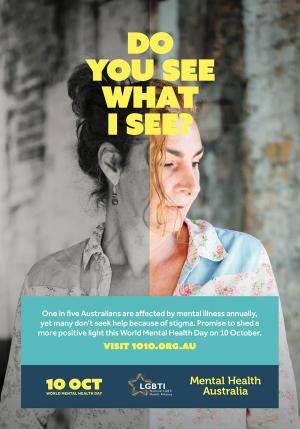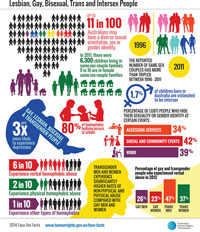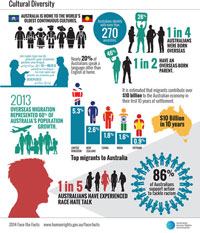Wellbeing
Wellbeing is a combination of a person’s physical, mental, emotional, social and spiritual health. For some it also includes connection to land, country and ancestors. Wellbeing is supported by values that place an emphasis on love and acceptance.
KEY POINTS
- Get informed about the experiences of multicultural LGBT individuals: don’t assume, start conversations, ask questions and LISTEN
- Reflect on how your own identities, values
and beliefs may influence the care you provide including your assumptions and expectations of others - Collaborate and
co create services and programs with the people who will use them - Consider how identity for some is not individual but collective: it includes clans, kinship
and ancestors, connection to land and belonging - Don’t leave families out, they need support too
- Bring in all layers of community, people are at different points, look for the connections
- If you are a community leader, use your influence to be an ally
- If you are a faith leader, use your influence to speak about love and belonging
- If you are a service provider, take an intersectional approach; systems are segmented, lived experience is not
- Just as there is no ‘one way to be gay’ consider options ‘coming out’, ‘coming home’ ‘coming in’

59% of Indigenous Australians reported experiences of discrimination
Average of 54% of African Australians reported experiences of discrimination, with experiences of discrimination being highest amongst South Sudanese individuals at 77%
34% of Muslims reported experiences of discrimination by religion
Higher levels of reported discrimination were found amongst most recent arrivals, with 22% amongst those from an English-speaking background and 41% amongst those from a non-English speaking background
The identities and experiences of LGBTIQ individuals from multicultural and faith-based communities are diverse and as such, there is no one-size-fits-all in promoting positive mental health and wellbeing.
A growing body of research and the voices of lived experience, have highlighted that LGBTIQ people navigate many challenges around their mental health, with individuals being more likely to be diagnosed with a mental illness, attempt suicide, and engage in self-harm compared to their heterosexual and cisgender peers1.
It is estimated that the prevalence of mental illness and suicide risk amongst immigrant communities is similar to that of non-immigrant communities and higher for those specifically from asylum-seeking and refugee backgrounds2, with risk factors such as high levels of social disadvantage and loss of kinship ties more common amongst multicultural Australian communities3.
Help-Seeking and Discrimination
Discrimination is a key issue impacting on the mental health and wellbeing of both LGBTIQ people and people from multicultural and diverse faith communities. Reports addressing the health and wellbeing of multicultural and faith-based communities, concurrent with reports addressing the health and wellbeing of LGBTIQ people, identify that whilst help-seeking from services is lower than the broader population, discrimination is particularly high amongst trans, Muslim, African, and Aboriginal Australian communities.2,4,5
The impacts of racism go beyond feelings and can have serious health effects, including biological, psychological and social consequences. Harms can also be more insidious reaching the core of one’s identity and impacting on people’s sense of self, sense of belonging and their experiences of safety in the world.
Beyond ‘we treat everybody the same’ indirect racism can be understood as the impact of ‘equal treatment’ on diverse groups, resulting in an unequal access to power, resources, and opportunities. A lack of awareness, limited understanding about peoples experiences and indifference are some of the invisible drivers of such racism.
Beyond individual acts of racism are the systemic impacts of structural racism. In this broader view, collective biases can join together, informed by assumptions, to create an environment where both macro and microaggressions can more easily occur and the experiences of diverse and intersecting identities become invisible.
Interconnected Experiences
While there is no comprehensive research on the number and mental health challenges of LGBTIQ individuals from multicultural and diverse faith backgrounds in Australia, qualitative reports have shown that LGBTIQ people who are also from multicultural and diverse faiths encounter a unique set of experiences navigating services and the broader community7, 8, 9. Some of the recurring issues in accessing mental health care have been a lack of understanding regarding the nuance and complexity of their experiences and interconnected identities.
Individuals have also reported experiencing discrimination from both the LGBTIQ community and their cultural and faith communities and feeling like they must disengage from one community identity to engage in the other. However, LGBTIQ individuals from multicultural and diverse faith backgrounds have also reported positive experiences with mental health providers and family/community members who are openly accepting and understanding of their identities,
Partnering with Community
Values emphasizing on love and acceptance for others have been shown to support positive mental health and wellbeing, and a greater acceptance for LGBT individuals among their families. For many, religious community leaders are seen as the ‘main gatekeepers’ 10 to community attitudes regarding LGBT individuals in multicultural and faith-based communities. As such, religious leaders play a pivotal role in influencing community attitudes and advocating for the safety and well-being of LGBT community members through actions such as ongoing consultations with families and community-led educational events.
Whilst LGBTIQ identity exists across time and
I think the mainstream culture of healthcare can use power in a very unidirectional way – the expert who holds the knowledge and the passive subjects who are there to receive care. It should be acknowledged that people are experts of their own lives and their concerns should be listened to and taken into consideration.
When we use the word LGBTI we ask:
History: How has the language we are using developed over time? What influence does it have?
Diversity within diversity: To which population within ‘LGBTI’ are we speaking? What are the different community wisdom, challenges, and insights of each population?
Deliberateness: How can we make sure that we move from habitually using all five letters to earning each of them?
Community character: What does each community share? What makes them distinct from each other? How can we connect with multiple views and perspectives within each group?
Limitations: How might the use of ‘LGBTI’ limit our ability to address an issue that is particularly important for a particular population but not necessarily shared?
Visibility: Whose voices are missing from the ‘LGBTI’ lens? How can we broaden our view to make sure we know who and what is missing and how to expand the frame?
Efficiency: ‘LGBTI’ is currently in popular use, how can we be brief and clear while making sure that diverse identities and key issues are conveyed?
Identity vs. Experience vs. Characteristics: How can we work with, across, and beyond identity labels in ways that make people and communities, be seen, feel heard and be understood?
Intersections: Communities can overlap and do not exist in isolation. Which overlaps do we need to consider when addressing a particular issue?
Adapted from: National LGBTI Health Alliance; Our approach to inclusive language
I believe [lack of cultural responsiveness in mental health care] forms part of my mental health issues – anxiety, depression, lack of self-worth, harsh inner critic etc. For me to gain a sense of connection with myself. I haven’t been able to find someone in Melbourne who caters to understanding LGBTI multicultural identities and
REFLECTIVE QUESTIONS
- When you meet an individual for the first time what ideas do you form; what influences this process?
- How do you communicate physical, psychological and social safety to people?
- What sorts of things do you do? What don’t you do? How inclusive is your environment?
- What supports you in working with LGBTIQ individuals from multicultural and diverse faith communities?
- What do you need more of?
RELATED VIDEOS
North Western Melbourne Primary Health Network (NWMPHN) asked LGBTIQ+ people to talk about their experiences accessing health care. Their responses will shock and surprise you.
Sistergirls Simone and Rosalina
This story is part of
QLives: Jason’s Story
HELPFUL LINKS
> Guide to sensitive care for LGB people attending general practice.
> LGBTI Health Alliance: Working therapeutically with LGBTIQ clients; a practice wisdom resource.
> LGBTIQ for General Practice; Trans GP Module
> Victorian Government Preliminary Multifaith Roundtable on LGBTI Youth in Victoria
> Wellways Out Together project: provides resources and training for LGBTIQ+ individuals registered under NDIS
REFERENCES
- Morris, S. (2016). Snapshot of mental health and suicide prevention statistics for LGBTI people and communities. National LGBTI Health Alliance: Sydney.
- Minas, H., Kakuma, R., Too, L. S., Vayani, H., Orapeleng, S.,…& Oehm, D. (2013). Mental health research and evaluation in multicultural Australia: developing a culture of inclusion. Mental Health in Multicultural Australia: Melbourne.
- Centre for Multicultural Youth (2014). Mind matters: the mental health and wellbeing of young people from diverse cultural backgrounds. Centre for Multicultural Youth: Melbourne.
- Rosenstreich, G. (2013). LGBTI people: mental health & suicide. Revised 2nd Edition. National LGBTI Health Alliance: Sydney.
- Markus, A. (2018). Australians today: Australian@2018 Scanlon Foundation survey. Scanlon Foundation, Australian Multicultural Foundation, & Monash University: Melbourne.
- Ferdinand, A., Paradies, Y., & Kelaher, M. (2013). Mental health impacts of racial discrimination in Victorian Aboriginal communities. Lowitja Institute: Melbourne.
- Mann, R., Horsley, P., Saunders, M., Briggs, V., & Mitchell, A. (2006). Swimming upstream: making places welcoming— a report on the needs of gay, lesbian and bi people in ‘hard to reach’ groups. Gay and Lesbian Health Victoria, & The Australian Research Centre in Sex, Health
and Society, La Trobe University: Melbourne. - Noto, O., Leonard, W., & Mitchell, A. (2014). “Nothing for
them ” understanding the support needs of LGBT young people from refugee and newly arrived backgrounds. Monograph series No. 94.The Australian Research Centre in Sex, Health & Society, La Trobe University: Melbourne. - Reeders, D. W. (2010). Double trouble? The health needs of culturally diverse men who have sex with men. Centre for Culture, Ethnicity
and Health: Melbourne. - Pallotta-Chiarolli, M. (2016). Supporting same-sex attracted and gender diverse young people of multicultural and multifaith backgrounds: executive summary and full research report. Melbourne: Equality Branch of the Department of Premier and Cabinet.


